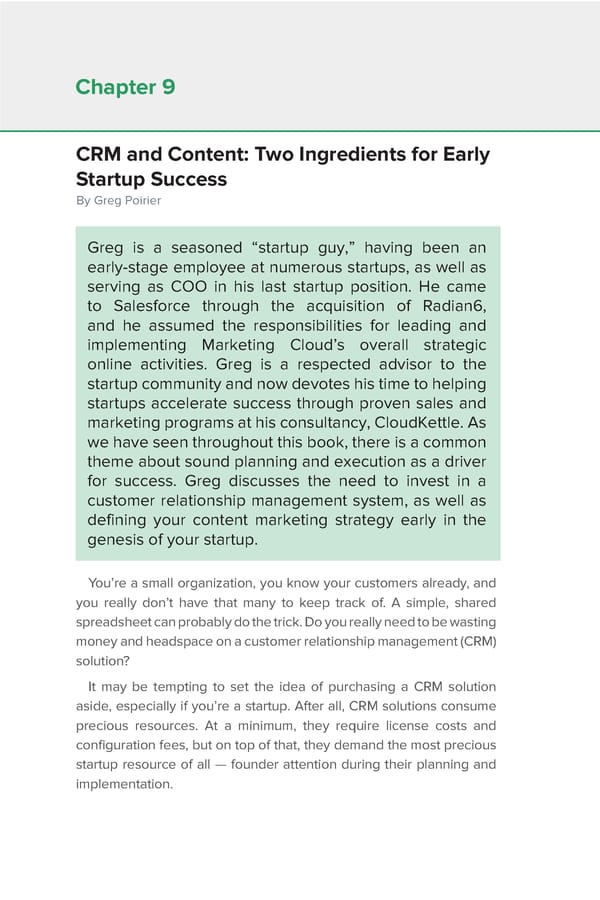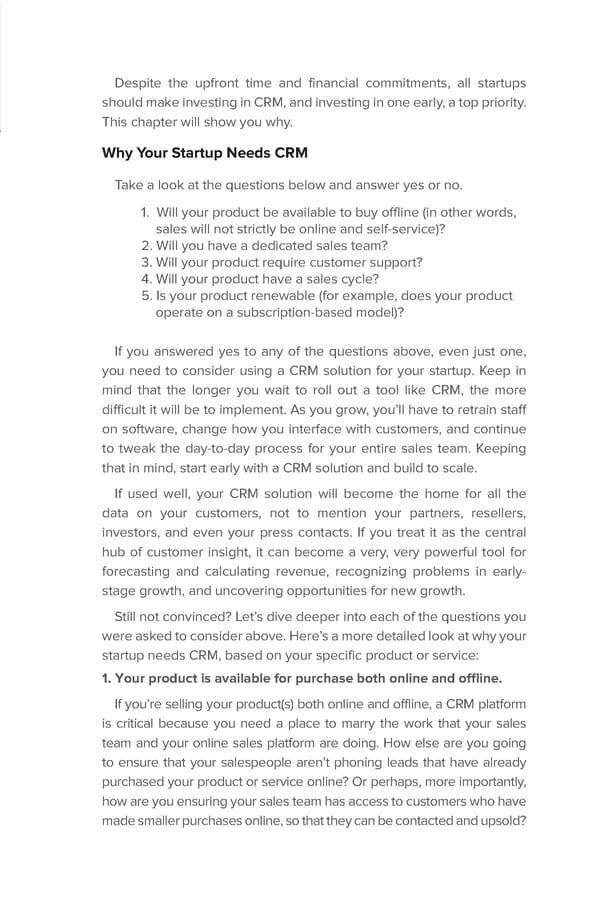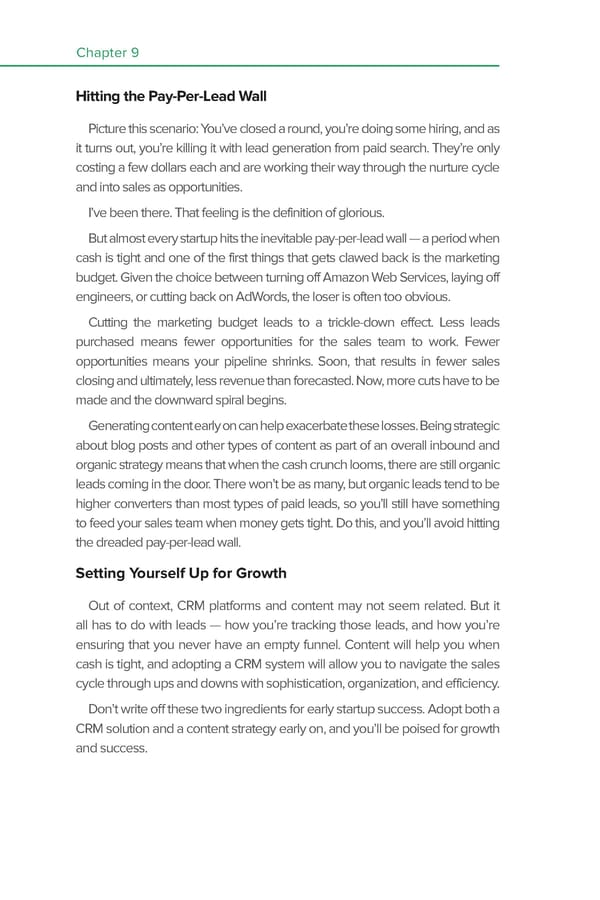CRM and Content
By Greg Poirier, CEO, CloudKettle
The SaaS Startup Founder’s Guide Concepts, Strategies, and Tactics from SaaS Leaders Table of Contents Introduction 7 Chapter 7 67 Sales Distribution & Segmentation Strategies - By Mike Wolff Chapter 1 10 Chapter 8 74 Subscription Economics: How Customer Experience and Success: Recurring Revenue Changes Both Science and Art Everything - By Tien Tzuo - By Melinda Gonzalez Chapter 2 24 Chapter 9 88 Do the Time CRM and Content: Two Ingredients - By Jason Lemkin and Aaron Ross for Early Startup Success - By Greg Poirier Chapter 3 34 Chapter 10 93 The Climb: How to Get to $10 Filling the Funnel with Content Million Marketing - By Tien Tzuo - By Amanda Nelson Chapter 4 38 Chapter 11 101 Are You a Nice-to-Have? Tools of the Trade - By Jason Lemkin and Aaron Ross - By Greg Poi Chapter 5 43 Contributing Authors 108 Nailing Your Go-to-Market Positioning - By Judy Loehr Chapter 6 56 About Salesforce for 113 Grow Revenue Faster with Startups Messaging Alignment, Playbooks and Onboarding - By Elay Cohen
Chapter 9 CRM and Content: Two Ingredients for Early Startup Success By Greg Poirier Greg is a seasoned “startup guy,” having been an early-stage employee at numerous startups, as well as serving as COO in his last startup position. He came to Salesforce through the acquisition of Radian6, and he assumed the responsibilities for leading and implementing Marketing Cloud’s overall strategic online activities. Greg is a respected advisor to the startup community and now devotes his time to helping startups accelerate success through proven sales and marketing programs at his consultancy, CloudKettle. As we have seen throughout this book, there is a common theme about sound planning and execution as a driver for success. Greg discusses the need to invest in a customer relationship management system, as well as defining your content marketing strategy early in the genesis of your startup. You’re a small organization, you know your customers already, and you really don’t have that many to keep track of. A simple, shared spreadsheet can probably do the trick. Do you really need to be wasting money and headspace on a customer relationship management (CRM) solution? It may be tempting to set the idea of purchasing a CRM solution aside, especially if you’re a startup. After all, CRM solutions consume precious resources. At a minimum, they require license costs and configuration fees, but on top of that, they demand the most precious startup resource of all — founder attention during their planning and implementation.
Despite the upfront time and financial commitments, all startups should make investing in CRM, and investing in one early, a top priority. This chapter will show you why. Why Your Startup Needs CRM Take a look at the questions below and answer yes or no. 1. Will your product be available to buy offline (in other words, sales will not strictly be online and self-service)? 2. Will you have a dedicated sales team? 3. Will your product require customer support? 4. Will your product have a sales cycle? 5. Is your product renewable (for example, does your product operate on a subscription-based model)? If you answered yes to any of the questions above, even just one, you need to consider using a CRM solution for your startup. Keep in mind that the longer you wait to roll out a tool like CRM, the more difficult it will be to implement. As you grow, you’ll have to retrain staff on software, change how you interface with customers, and continue to tweak the day-to-day process for your entire sales team. Keeping that in mind, start early with a CRM solution and build to scale. If used well, your CRM solution will become the home for all the data on your customers, not to mention your partners, resellers, investors, and even your press contacts. If you treat it as the central hub of customer insight, it can become a very, very powerful tool for forecasting and calculating revenue, recognizing problems in early- stage growth, and uncovering opportunities for new growth. Still not convinced? Let’s dive deeper into each of the questions you were asked to consider above. Here’s a more detailed look at why your startup needs CRM, based on your specific product or service: 1. Your product is available for purchase both online and offline. If you’re selling your product(s) both online and offline, a CRM platform is critical because you need a place to marry the work that your sales team and your online sales platform are doing. How else are you going to ensure that your salespeople aren’t phoning leads that have already purchased your product or service online? Or perhaps, more importantly, how are you ensuring your sales team has access to customers who have made smaller purchases online, so that they can be contacted and upsold?
Chapter 9 CRM and Content: Two Ingredients for Early Startup Success Use your CRM platform to track this information and position your sales team in the right pocket to expand to new divisions. 2. You already have, or plan to have, a dedicated sales team. Sales teams are critical, especially for B2B plays. But the most successful sales teams use CRM platforms that allow them to track all their work, store contact info on leads, and keep a history of where that lead is in the sales cycle. Then, when you finally reach that sale point, a good CRM solution allows your team to track contract changes — if it was signed, when invoicing occurred, and when to follow up on renewal. Can your spreadsheet do that? Traditional spreadsheets and corporate memory significantly undercut today’s sophisticated sales cycles and processes. Don’t sell yourself short. In addition to tracking sales cycles, a CRM system can track your sales team’s performance. Is your team converting leads to opportunities at an acceptable rate? How many sales are they making? How much opportunity pipeline is coming down the next fiscal quarter? Will it be enough to sustain your burn rate? These are all the questions that regular reporting inside a CRM system can help you plan for and answer. 3. Your product will require customer support. So you’re selling SaaS or some other digital product. Is it going to require support? Assuming so, how are you tracking this support? Where are you going to keep track of the support calls and inquiries you receive? How are you going to track which issues occur most often, so you can dig in and figure out what causes them? When you get support calls, where is your support team going to look up information (like previous support cases) on your client, so they can provide them excellent service? How is your sales team going to know that they shouldn’t make a renewal sales pitch this week because the customer has had three support calls and isn’t happy? In it’s most simple form, a CRM solution is a tool that can help you keep track of those pain points in a way that’s transparent and efficient. In short, it will make your life, and your customers’ lives, a whole lot easier.
Chapter 9 CRM and Content: Two Ingredients for Early Startup Success 4. Your product has a sales cycle or renewals. If you sell a subscription-based SaaS, you fall into this category. You might not be thinking about renewable, recurring revenue now, but getting a repeat purchase is much less resource intensive than bringing a new customer on board. Churn is a big problem for startups, often because in the hustle to get new customers, little or no attention is paid to keeping the ones you currently have. Renewals might not sound as sexy as new customers — but guaranteed, they’re the heart and soul of your business. In terms of sales cycle, there are very few products that don’t have one. If you sell something that has a higher price point and a longer lead-to-sale process, using a CRM solution is even more important. You need a way to track your leads as you nurture them from being a random person that visited your site, to a form completion, a request for a trial, contacts with the sales team, and then hopefully a sale. And then, of course, comes renewals. How are you going to ensure that customers are contacted again when they plan their next budget, so you aren’t on the chopping block? How are you tracking the date their credit card expires, so a friendly sales rep follows up with them to update their information? These are all data points that can, and should, be monitored in a CRM system. Why Your Startup Needs Content Content marketing is a concept that many startups struggle with, mainly because it requires near-term concentrated investments of time. Early- stage companies are very time-poor, and the idea of sitting down and spending hours creating content can seem ridiculous. If you’re like most startups, you probably know that content is something you need to spend time on, but with your inbox count ticking upward with every word you type, who can justify spending an afternoon creating a blog post that might generate inbound traffic in six months? It’s true, focusing on content marketing probably isn’t going to generate an organic inbound lead the day you publish a blog post. Perhaps you’ll start seeing a trickle of organic search visits after a month, maybe a few more after three months. Maybe your true organic traffic potential for that post is reached after six months. That’s a long time to wait for the ROI of a blog post, but smart startups know it’s usually worth the wait.
Chapter 9 CRM and Content: Two Ingredients for Early Startup Success Hitting the Pay-Per-Lead Wall Picture this scenario: You’ve closed a round, you’re doing some hiring, and as it turns out, you’re killing it with lead generation from paid search. They’re only costing a few dollars each and are working their way through the nurture cycle and into sales as opportunities. I’ve been there. That feeling is the definition of glorious. But almost every startup hits the inevitable pay-per-lead wall — a period when cash is tight and one of the first things that gets clawed back is the marketing budget. Given the choice between turning off Amazon Web Services, laying off engineers, or cutting back on AdWords, the loser is often too obvious. Cutting the marketing budget leads to a trickle-down effect. Less leads purchased means fewer opportunities for the sales team to work. Fewer opportunities means your pipeline shrinks. Soon, that results in fewer sales closing and ultimately, less revenue than forecasted. Now, more cuts have to be made and the downward spiral begins. Generating content early on can help exacerbate these losses. Being strategic about blog posts and other types of content as part of an overall inbound and organic strategy means that when the cash crunch looms, there are still organic leads coming in the door. There won’t be as many, but organic leads tend to be higher converters than most types of paid leads, so you’ll still have something to feed your sales team when money gets tight. Do this, and you’ll avoid hitting the dreaded pay-per-lead wall. Setting Yourself Up for Growth Out of context, CRM platforms and content may not seem related. But it all has to do with leads — how you’re tracking those leads, and how you’re ensuring that you never have an empty funnel. Content will help you when cash is tight, and adopting a CRM system will allow you to navigate the sales cycle through ups and downs with sophistication, organization, and efficiency. Don’t write off these two ingredients for early startup success. Adopt both a CRM solution and a content strategy early on, and you’ll be poised for growth and success.




